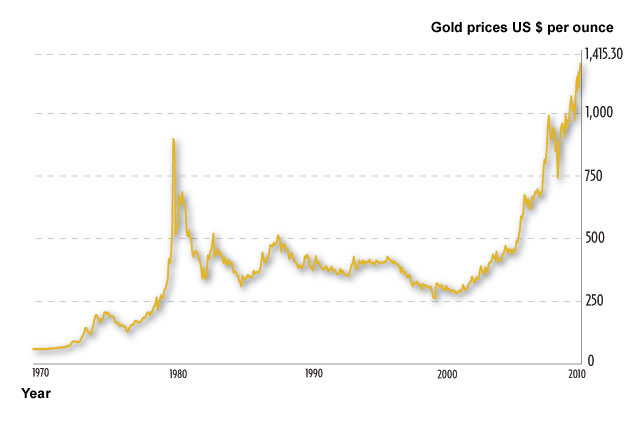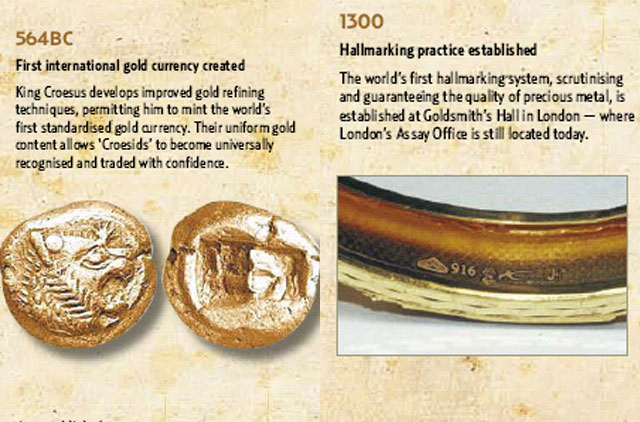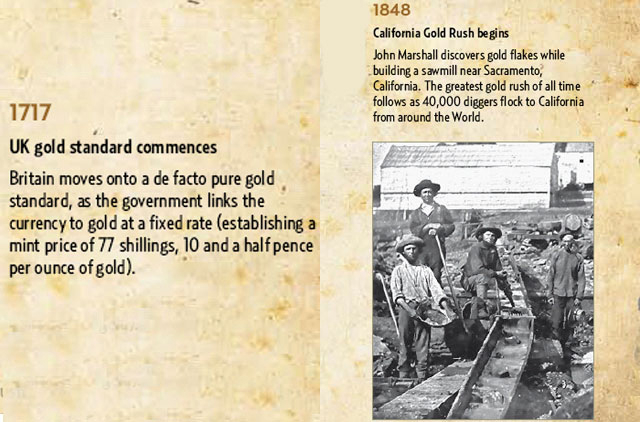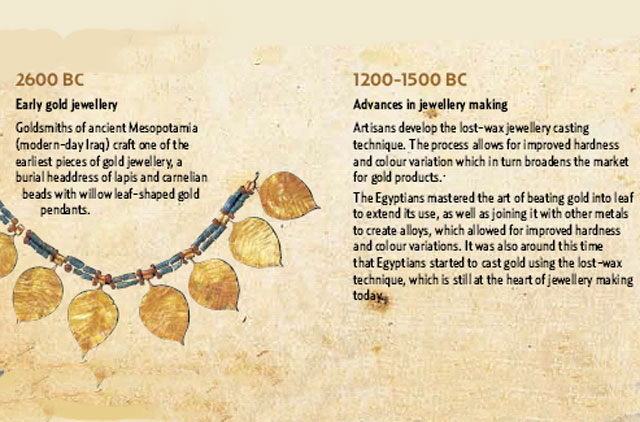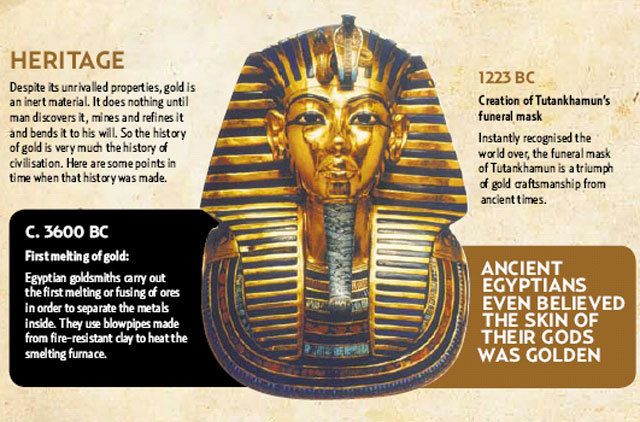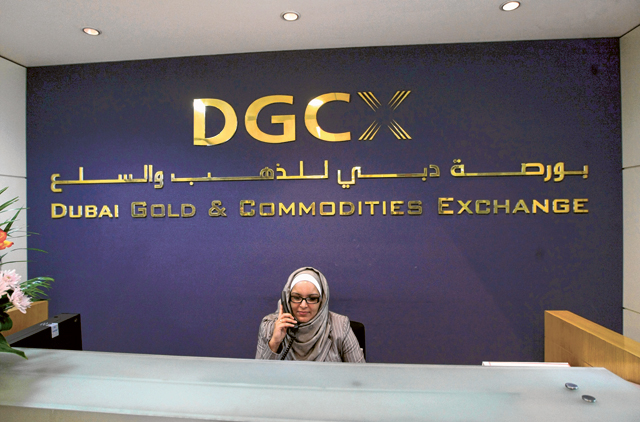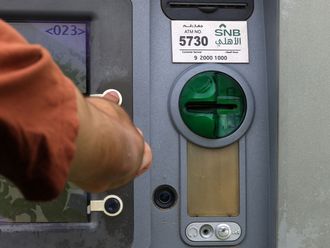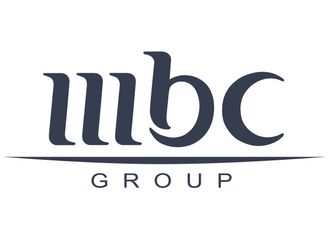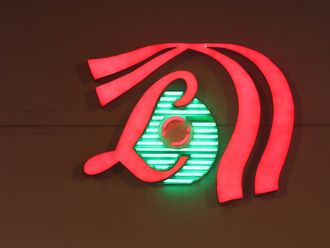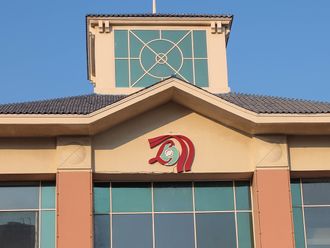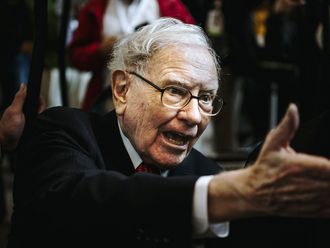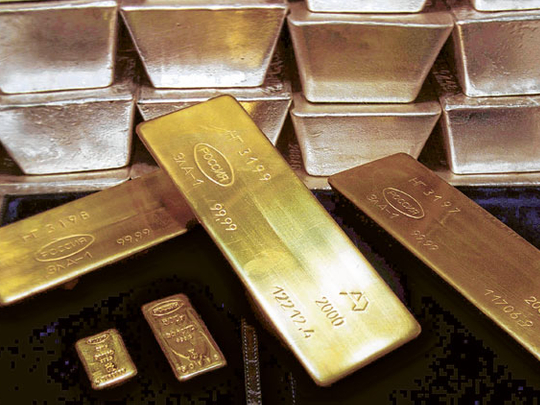
Dubai On January 24, 1848, carpenter James Marshall fished two glittering gold nuggets out of the American River, unwittingly marking the epicentre of what would become the California Gold Rush.
Within a year, 40,000 miners with "the fever" descended upon the region, leaving no creek stone unturned in the hunt for the mythical mother lode.
Dreams of striking it rich never panned out for most.
According to experts, more than 90 per cent of the world's existing 165,000 metric tonnes of gold reserves and jewellery has been mined since that innocent first discovery in a California riverbed.
And with only an average 2,500 tonnes of gold now produced annually worldwide, a renewed gold rush annually worldwide, a renewed gold rush amid volatile financial
times has pushed gold to all-time highs of more than $1,400 (Dh5,142) per ounce.
The new Gold Rush of 2010 has seen gold reach new highs more than 35 times this year to the point that it is now worth 400 per cent more than it was a decade ago, according to the World Gold Council.
With those kinds of returns, total global gold demand reached a record high of $137.5 billion from the third quarter of 2009 to the third quarter of this year.
Investors from the United Arab Emirates are joining the feeding frenzy amid predictions that gold prices will continue to trend upward well into 2012.
In its latest Global Demand Trends report, the World Gold Council said that "the UAE experienced healthy growth in net demand," with consumer demand for investment gold jumping by 57 per cent to $63 million in this year's third quarter alone.
From third quarter 2009 to third quarter 2010, total annual UAE demand for net retail investment gold jumped 28 per cent with investors shelling out $267 million, up from $209 million a year before.
In Dubai alone, the total value of gold traded in the first quarter of 2010 amounted to $8.3 billion, up from the $7.4 billion in gold traded in first quarter 2009, according to statistics compiled by Dubai World Statistics Department.
In 2009, Dubai enjoyed $29.3 billion in gold trading, the statistics department recorded.
Marcus Grubb, Managing Director Investment for the World Gold Council, attributed the newest global gold rush to "the rediscovery of gold's properties as both a currency and a monetary asset."
The World Gold Council said in late November that investors' demand for gold is not likely to wane given a market surge earlier this year that was "supported by heightened sovereign risk and currency worries."
"Concern over fiscal imbalances and currency tensions will continue to support investment demand for gold. Aside from the recent additional $600 billion of quantitative easing (QE2) by the US, the weakening of the US dollar and associated fears of inflation, demand is also likely to be driven by higher gold price expectations as well as increasing availability and accessibility of gold investment products to retail investors," the council said in a statement.
Yogaani Bhatia, UAE Country Manager for the World Gold Council, told Gulf News that the latest gold rush is not "an overnight jump. Arrival at the current trading range of around $1,400 has been a measured rise, supported by a combination of favourable gold fundamentals, which remain strong today."
"During such times, gold plays a crucial role in underpinning wealth. Those institutions and individuals with an exposure to gold have enjoyed stability to their portfolio that others haven't. Even a small allocation of gold has been proven to make portfolios more robust and reduce the variability of returns," Bhatia said.
"Gold will continue to have a crucial role in the coming period, not only due to the shift towards wealth preservation, but also because investors with gold in their portfolio will be more comfortable with a return to risk assets. It provides investors with the confidence to invest in risk assets to generate long term returns. This is because gold's broad demand and supply drivers provide a unique balance in the face of economic volatility and uncertainty, allowing gold to move independently of other assets."
Bhatia said Dubai's historic role as a trading hub for gold serves as a solid backdrop to increased investments in gold domestically.
"Dubai is aptly named the City of Gold, as its role in the gold market has been significant for many hundreds of years. The precious metal has been an important part of the fabric of life in the Middle East for generations, and we do not see that changing in the future," Bhatia said.
"You just have to look at the bustling Old Gold Souq and the modern gold jewellery showrooms to see that demand for gold jewellery remains strong in the region. We have seen strong demand in the UAE around religious festivals in particular in 2010 and we expect this trend to continue."
Investment analysts also believe gold will continue to climb as world leaders wrestle with growing uncertainty about Western markets in the US and Europe.
Gary Dugan, Emirates NBD Chief Investment Officer, believes the world has entered what he calls the Golden Era of Gold.
"It isn't a golden week, a golden two or three years, it's a golden decade," Dugan said. "Fundamentally, there is short supply and there will be consistent demand."
Asked if gold will plummet in crash-like fashion in the near future, Dugan replied that scenario is unlikely because world uncertainty continues to buoy gold demand as a hedge against the unforeseen.
"Last year, you might get a $100 move [in gold prices] … but a crash is very unlikely," he said, noting that an ageing population in the West coupled with a rebalancing of power from West to East will not retrieve the economic certainty of markets enjoyed in the 1990s which kept gold prices low and currencies strong.
In a new Emirates NBD report, Dugan said: "Gold is your friend through periods of stress. We believe that the global imbalances will continue to generate financial stress in the global economy for some years to come, hence gold will remain very much in investors minds.
"Global certainty and low volatility has been replaced with financial stress and high volatility. While the domination [by] eastern economies is a widely held view, no one is too sure how the baton of global leadership can seamlessly shift from West to East."
Walter De Wet, Head of Commodities Research at Standard Bank in London, agreed that uncertainty is bolstering demand but noted there are other factors at work in pushing gold prices through the roof.
De Wet told Gulf News that, "we believe the main driver is low real interest rates in major economies such as the US and China which is driving investment demand into real assets such as gold. On top of this we have an increased interest from especially EM central banks [emerging markets] to buy gold, although the amount of gold these guys are buying are still small.
Crisis hedge
Purchasing power
Aesop's fable of the Tortoise and the Hare could equally apply to the story of gold versus currency over the centuries.
Slow and steady, gold has won the race in terms of value, it would appear, over the hare when one looks at the buying power of both over the long term.
According to the World Gold Council, since "the 14th Century, gold's purchasing power has maintained a broadly constant level. To put this in practical terms, an ounce of gold has repeatedly bought a mid-range outfit of clothing."
An ounce of gold was worth around $2 in the 14th Century and could buy a nice wardrobe while today at more than $1,400 per ounce can still outfit a person with an acceptable outfit.
By contrast, the World Gold Council pointed out that "the US dollar that bought 14.5 loaves of bread in 1900 buys only [three-quarters] of a loaf today. While inflation and other forces have ravaged the value of the world's currencies, gold has emerged with its capacity for wealth preservation firmly intact. Being no one's liability, gold exhibits the same wealth preserving qualities in the face of financial turmoil, earning a reputation as a crisis hedge in addition to its credentials as an inflation hedge."
Reserves store
Dubai Multi Commodities Centre
Dubai Opened in April 2009 in Jumeirah Lakes Towers, the new Dubai Multi Commodities Centre at Almas Tower stores an unspecified amount of gold in what the DMCC calls "world-class vaulting."
Operated 24 hours a day, seven days a week by Brink's Global Services, the vault holds gold reserves allocated by some of the 300 gold companies now registered with the DMCC in Dubai.
Malcom Wall Morris, Chief Executive Officer of DMCC, declined to give physical details of the new vault for security purposes but said the high-security premises is welcomed given DMCC member companies are reporting "40 per cent annual growth."
The DMCC, meanwhile, said in a statement that the "vault combines the advantages of a unique location with the highest global security standards for the short and long term storage of precious metals and other high value products."
The DMCC said it houses the "latest and most sophisticated security equipment."
Trading hub
Dubai benefits from expanding demand
Consumers aren't simply buying gold in bullion in record numbers to shore up their investment portfolios.
The World Gold Council said more people are buying gold in the form of jewellery for cultural and beauty aspects as well.
"In East Asia, India and the Middle East, gold has a powerful cultural meaning, accounting for approximately 70 per cent of the world's gold jewellery in 2009," the Council said. "Around 60 per cent of today's gold becomes jewellery where Indian and China with their expanding economic power are at the forefront of consumption."
The gold jewellery industry in the UAE, for example, accounts for billions in yearly sales resulting in a trickle-down effect that creates jobs, private-sector spending and acts as a draw for the sale of other precious metals such as silver.
According to World Gold Council figures, gold jewellery sales in the UAE jumped 17 per cent, or roughly $400 million, from $2.1 billion in the third quarter of 2009 to $2.5 billion in the third quarter of this year.
Alison Burns, Regional Head of Precious Metals Mena for Standard Bank, said that Dubai is well positioned to benefit from expanding demand for gold.
"The UAE's geographically convenient position as well as its years of expertise should serve it well as a growing hub in this overall positive gold economic environment."
And as demand for recycled gold grows globally, Dubai can capitalise on gold imports and exports from the region, she said.
"The United Arab Emirates has developed as a precious metals trading hub over a considerable amount of years and has witnessed strong flows of both gold jewellery product and gold jewellery scrap in and out of the region," she said.
"We see this type of physical gold business continuing to flourish in the coming years with bias either on jewellry demand or scrap supply depending on price conditions. We also note the considerable increase in investor demand for physical metal all of which can be sourced from within the liquidity of the UAE gold physical markets," Burns said.
Firoz G. Merchant, Chairman, Pure Gold Jewellers, said sales of jewellery have yielded historic highs.
"Gold has continued its long upward march this year reaching dramatic proportions of [more than a] 300 per cent increase in price over the last decade," Merchant told Gulf News. "The reasons can be attributed to various factors like collapse of the US dollar, emerging economies increasing their gold reserve and lower interest rates. People are increasingly embracing gold as a hedge against economic uncertainties, as they have in the past."
"Governments are losing their trust in paper currency, investors who earlier bought gold have seen the positive result of doing so and with global uncertainty consistently persisting, they are continuing to invest in gold. The precious metal has over the last 5 years given an annual return of approx 20 to 25 per cent return."
Merchant attributed the high popularity of gold jewellery to its staying power as "a safe haven in times of inflation or economic uncertainties. For example, gold and gold stocks did well during the Depression of the 1930s."
Customers who own gold jewellery can always exercise the option of selling it at spot prices if situations warrant.
"Gold is a global commodity and very liquid. The fact that trading in gold is so easy and transparent makes it very attractive to investors and hence makes it valuable," Merchant said.
No hassle gold trading demands coupled with the UAE's long association with the precious metal are a good combination, he said.
"UAE has a very strong footing as far as gold is concerned and this is here to stay. The Government continues to promote and protect the interests of the gold and jewellery sector. With its close proximity to strong gold markets like India, Turkey and China, the UAE is well positioned as a hub for the gold and jewellery industry. I strongly believe that UAE's importance as a key market place for gold will only grow internationally in the future," he said.
40 YEARS HISTORY OF GOLD PRICE
August 1971 - President Richard Nixon takes the dollar off the gold standard, which had been in place with minor modifications since the Bretton Woods Agreement of 1944 fixed the conversion rate for one Troy ounce of gold at $35.
August 1972 - The United States devalues the dollar to $38 per ounce of gold.
March 1973 - Most major countries adopt floating exchange rate system.
May 1973 - U.S. devalues dollar to $42.22 per ounce.
1976 - The Gold Institute is established to promote thecommon business interests of the gold industry by providing statistical data and other relevant information to its members, the media, and the public, while also acting as an industry spokesperson.
January 1980 - Gold hits record high at $850 per ounce. High inflation because of strong oil prices, Soviet intervention in Afghanistan and the impact of the Iranian revolution, prompts investors to move into the metal.
1986 - The first new gold jewelry alloy this century, 990- Gold (1% titanium) is introduced to meet the need for an improved durability of 99% pure gold traditionally manufactured in Hong Kong. The very malleable alloy is easily worked into intricate design, but can be converted into a hard, durable alloy by simply heating it in an oven.
1987 - The World Gold Council is established to sustain and develop demand for the end uses of gold.
1992 - World Gold Council introduces the Gold Mark as an international identification mark for gold jewelry.
August 1999 - Gold falls to a low at $251.70 on worries about central banks reducing reserves of gold bullion and mining companies selling gold in forward markets to protect against falling prices.
October 1999 - Gold reaches a two-year high at $338 after agreement to limit gold sales by 15 European central banks. Market sentiment toward gold begins to turn more positive.
February 2003 - Gold reaches a 4-1/2 year high on safe-haven buying in run-up to conflict with Iraq.
December 2003 -January 2004 - Gold breaks above $400, reaching levels last traded in 1988. Investors increasingly buy gold as risk insurance for portfolios.
November 2005 - Spot gold breaches $500 for the first time since December 1987, when spot hit $502.97.
April 11, 2006 - Gold prices surpass $600, the highest point since December 1980, with funds and investors pouring money into commodities on a weak dollar, firm oil prices and geopolitical worries.
May 12, 2006 - Gold prices peak at $730 an ounce with funds and investors pouring money into commodities on a weak dollar, firm oil prices and political tensions over Iran's nuclear ambitions.
June 14, 2006 - Gold falls 26 percent to $543 from its 26-year peak after investors and speculators sell out of commodity positions.
November 7, 2007 - Spot gold hits a 28-year high of $845.40 an ounce.
January 2, 2008 - Spot gold breaks above $850.
March 13, 2008 - Benchmark gold contract trades over $1,000 for the first time in U.S. futures market.
March 17, 2008 - Spot gold hits an all-time high of $1,030.80 an ounce. U.S. gold futures touch record peak of $1,033.90.
September 17, 2008 - Spot gold rises by nearly $90 an ounce, a record one-day gain, as investors seek safety amid turmoil on the equity markets.
February 20, 2009 - U.S. gold futures rise back above $1,000 an ounce to a peak of $1,000.30 as investors turn back to gold as major economies face recession and equity markets tumble.
December 10, 2010 - Gold hits record high at $1415.30 per ounce.


